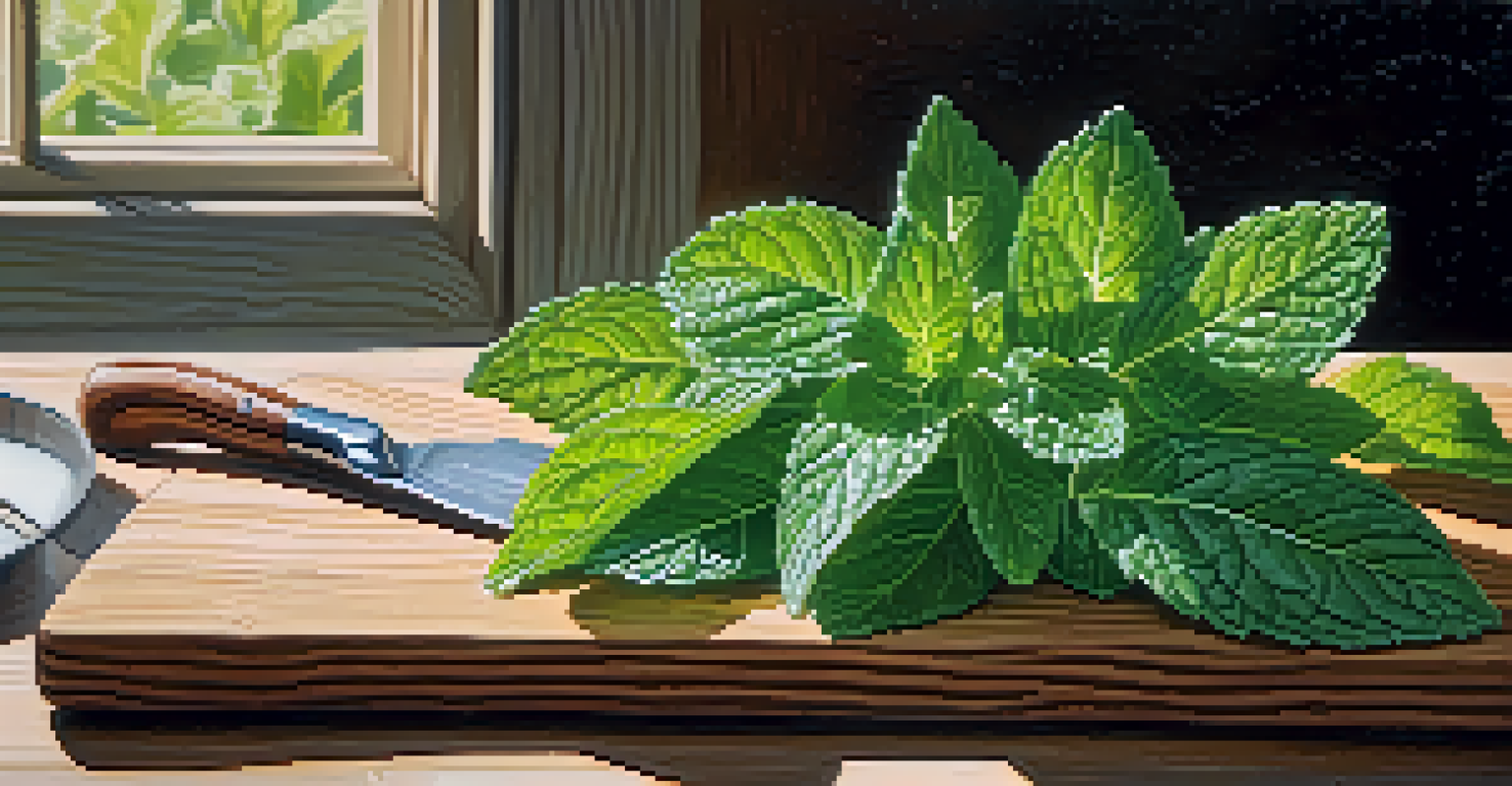Growing Mint: Tips for Cultivating and Using This Versatile Herb

Understanding the Different Types of Mint to Grow
Mint comes in various types, each with unique flavors and uses. Common varieties include spearmint, peppermint, and chocolate mint, each bringing its own flair to dishes and drinks. Knowing the differences can help you choose the best one for your garden or kitchen.
Mint is the spice of life. It adds freshness and flavor to everything it touches.
For example, spearmint is often used in recipes like tabbouleh and mojitos, while peppermint is a favorite for teas and desserts. Chocolate mint, with its distinct aroma, adds a fun twist to sweet treats. Understanding these varieties allows you to experiment and find your personal favorite.
So, whether you're looking to enhance your cooking or create refreshing beverages, selecting the right mint variety is the first step to success.
Choosing the Right Location for Mint Growth
Mint loves partial sunlight, making it essential to choose a location that offers a good balance of light and shade. Ideally, find a spot that gets about 4 to 6 hours of sunlight each day. Too much sun, and your mint may wilt; too little, and it could become leggy and sparse.

Additionally, mint can be quite invasive if planted directly in your garden. To control its spread, consider planting it in containers or raised beds. This way, you can enjoy its fresh flavors without worrying about it overtaking your garden.
Choose the Right Mint Variety
Different mint varieties like spearmint, peppermint, and chocolate mint each offer unique flavors and uses for your culinary adventures.
By carefully selecting the right location, you'll set your mint up for a healthy and productive growing season.
Preparing the Soil for Optimal Mint Growth
Mint thrives in well-drained soil that’s rich in organic matter. Before planting, it’s a good idea to amend your soil with compost or well-rotted manure to improve its nutrient content. This will help provide the essential elements that mint needs to flourish.
The greatest gift of the garden is the restoration of the spirit.
Additionally, ensure your soil has a pH level between 6.0 and 7.0 for best results. You can easily test your soil's pH using a home testing kit. If adjustments are needed, simple additives like lime can raise pH, while sulfur can lower it.
Proper soil preparation creates a strong foundation for your mint plants, promoting healthy growth and flavorful leaves.
Watering Your Mint: Finding the Right Balance
Mint prefers consistently moist soil, but it’s crucial to avoid overwatering. A good rule of thumb is to water your mint when the top inch of soil feels dry. This ensures that the plant gets the hydration it needs without becoming waterlogged.
In hot weather or dry spells, you may need to increase your watering frequency. Conversely, during cooler months, you can scale back since mint’s growth will slow down. Observing your plants can help you determine their specific needs.
Optimal Location for Mint Growth
Mint thrives in partial sunlight and can become invasive, so it's best to plant it in containers or raised beds to control its spread.
Remember, balanced watering is key to keeping your mint healthy and vibrant throughout the growing season.
Fertilizing Mint for Robust Growth and Flavor
While mint isn’t a heavy feeder, applying a balanced fertilizer every few weeks can enhance its growth and flavor. Look for organic options like fish emulsion or seaweed fertilizer, which can provide a gentle nutrient boost. This will support healthy leaf production and overall plant vigor.
It's best to fertilize mint during the active growing season, typically from spring to early summer. Be cautious not to over-fertilize, as this can lead to excessive leaf growth at the expense of flavor.
With the right amount of nourishment, your mint will thrive, and you’ll enjoy a bountiful harvest of flavorful leaves.
Pruning Mint for Healthy Growth and Flavorful Leaves
Regular pruning is essential for maintaining the health of your mint plants. By trimming back the stems, you encourage bushier growth and prevent the plants from becoming leggy. Aim to prune about one-third of the plant every few weeks during the growing season.
Pruning not only helps the plant stay compact, but it also promotes the production of more flavorful leaves. The more you harvest, the more mint will grow, creating a cycle of abundance in your garden.
Proper Care for Healthy Mint
Regular pruning, balanced watering, and occasional fertilizing are essential practices to ensure robust growth and flavorful leaves.
So, grab your scissors and get pruning; your mint will thank you with plenty of fresh leaves!
Harvesting and Using Mint in Your Kitchen
When it comes to harvesting mint, timing is everything. The best time to pick mint is just before the plant flowers, as that’s when the leaves are at their most flavorful. Use clean scissors to snip off the stems, taking care not to remove more than one-third of the plant at once.
Mint can be used in countless dishes, from fresh salads to infused beverages. Consider muddling it into cocktails or adding it to yogurt for a refreshing dip. Its versatility makes it a staple herb in many kitchens.

With fresh mint on hand, you’ll be inspired to get creative in the kitchen, elevating your dishes with its aromatic presence.